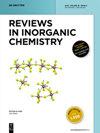Unveiling the multifaceted roles of protonated 1,2-bis(4-pyridyl)ethylene (HBpe+) ligand in metal-driven supramolecular assembly: a comprehensive structural review
IF 3.1
3区 化学
Q1 CHEMISTRY, INORGANIC & NUCLEAR
引用次数: 0
Abstract
A protonated form of 1,2-bis(4-pyridyl)ethylene (HBpe揭示质子化 1,2-双(4-吡啶基)乙烯 (HBpe+) 配体在金属驱动的超分子组装中的多方面作用:结构综述
通过质子转移或 pH 值调节产生的质子化形式的 1,2-双(4-吡啶基)乙烯(HBpe+)在形成独特的超分子结构方面发挥着重要作用。相比之下,该分子的非质子化形式(Bpe)在金属有机络合物中得到了广泛研究。在这篇综述中,我们将探讨 HBpe+ 作为配位化学领域中的单价配体的迷人世界。文章讨论了质子配体如何影响超分子结构的组装及其性质和功能。结果往往会形成 1:1 加合物、配位聚合物和金属簇等结构。在这些组装体中,HBpe+ 会发生各种相互作用,从而影响其超分子行为。这些相互作用包括与金属离子的配位复合物、氢键、芳香环堆积和双键堆积(π⋯π 堆积)。配体的柔性和构象对配合物的整体结构和稳定性有重大影响。通过揭示 HBpe+ 在超分子组装中的独特属性和作用,为开发功能材料打开了大门。有了这些见解,就有可能通过受控组装过程探索 HBpe+ 的功能特性,从而创造出创新的功能材料。
本文章由计算机程序翻译,如有差异,请以英文原文为准。
求助全文
约1分钟内获得全文
求助全文
来源期刊

Reviews in Inorganic Chemistry
化学-分析化学
CiteScore
7.30
自引率
4.90%
发文量
20
审稿时长
1 months
期刊介绍:
Reviews in Inorganic Chemistry (REVIC) is a quarterly, peer-reviewed journal that focuses on developments in inorganic chemistry. Technical reviews offer detailed synthesis protocols, reviews of methodology and descriptions of apparatus. Topics are treated from a synthetic, theoretical, or analytical perspective. The editors and the publisher are committed to high quality standards and rapid handling of the review and publication process. The journal publishes all aspects of solid-state, molecular and surface chemistry. Topics may be treated from a synthetic, theoretical, or analytical perspective. The editors and the publisher are commited to high quality standards and rapid handling of the review and publication process.
Topics:
-Main group chemistry-
Transition metal chemistry-
Coordination chemistry-
Organometallic chemistry-
Catalysis-
Bioinorganic chemistry-
Supramolecular chemistry-
Ionic liquids
 求助内容:
求助内容: 应助结果提醒方式:
应助结果提醒方式:


